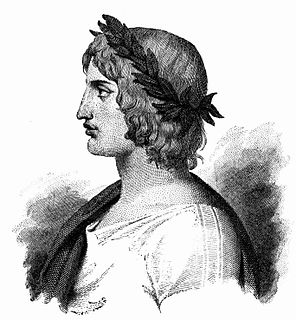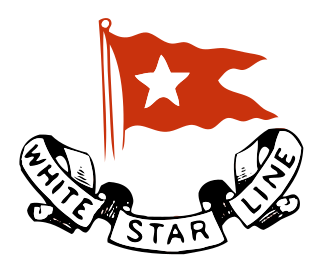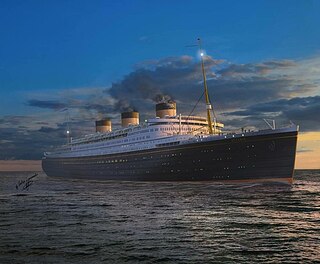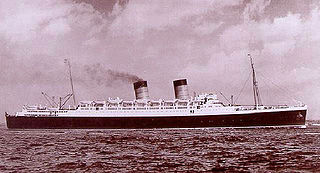
Publius Vergilius Maro, usually called Virgil or Vergil in English, was an ancient Roman poet of the Augustan period. He wrote three of the most famous poems in Latin literature: the Eclogues, the Georgics, and the epic Aeneid. A number of minor poems, collected in the Appendix Vergiliana, are sometimes attributed to him.

RMS Olympic was a British transatlantic crossing ocean liner, the lead ship of the White Star Line's trio of Olympic-class liners. Unlike the other ships in the class, Olympic had a long career spanning 24 years from 1911 to 1935. This included service as a troopship during the First World War, which gained her the nickname "Old Reliable". She returned to civilian service after the war and served successfully as an ocean liner throughout the 1920s and into the first half of the 1930s, although increased competition, and the slump in trade during the Great Depression after 1930, made her operation increasingly unprofitable.

Cunard Line is a British–American cruise line based at Carnival House at Southampton, England, operated by Carnival UK and owned by Carnival Corporation & plc. Since 2011, Cunard and its three ships have been registered in Hamilton, Bermuda.

The coat of arms of Prince Edward Island was begun when the shield and motto in the achievement were granted in 1905 by royal warrant of the King Edward VII.

The Oceanic Steam Navigation Company, more commonly known as the White Star Line, was a British shipping company. Founded out of the remains of a defunct packet company, it gradually rose up as one of the most prominent shipping lines in the world, providing passenger and cargo services between the British Empire and the United States. While many other shipping lines focused primarily on speed, White Star branded their services by focusing more on providing steady and comfortable passages, for both upper class travelers and immigrants. Today it is most famous for the innovative vessel Oceanic of 1870, and for the losses of some of their best passenger liners, including the wrecking of RMS Atlantic at Halifax in 1873, the sinking of RMS Republic off Nantucket in 1909, the infamous loss of RMS Titanic in 1912 and that of HMHS Britannic while serving as a hospital ship in 1916. Despite its casualties, the company retained a prominent hold on shipping markets around the globe before falling into decline during the Great Depression, which ultimately led to a merger with its chief rival, Cunard Line, which operated as Cunard-White Star Line until 1950. Cunard Line then operated as a separate entity until 2005 and is now part of Carnival Corporation & plc. As a lasting reminder of the White Star Line, modern Cunard ships use the term White Star Service to describe the level of customer care expected of the company.

The RMMV Oceanic was the planned name of an unfinished ocean liner that was partially built by Harland and Wolff for the White Star Line. The ship was to have been the first 1,000-foot (300 m)-long ocean liner. It was intended to be the largest ocean liner for the White Star Line, thus it would have been larger than the earlier White Star giants, Olympic, Titanic, Britannic, and Majestic.

RMS Baltic was an ocean liner of the White Star Line that sailed between 1904 and 1933. At 23,876 gross tons, she was the world's largest ship until 1905. She was the third of a quartet of ships, all measuring over 20,000 gross tons, dubbed The Big Four.

Joseph Bruce Ismay was an English businessman who served as chairman and managing director of the White Star Line. In 1912, he came to international attention as the highest-ranking White Star official to survive the sinking of the company's brand new flagship RMS Titanic, for which he was subject to severe criticism.

RMS Mauretania was launched on 28 July 1938 at the Cammell Laird yard in Birkenhead, England, and was completed in May 1939. The second Mauretania was the first ship built for the newly formed Cunard White Star company following the merger in April 1934 of the Cunard and White Star Line. On the withdrawal of the first RMS Mauretania in 1934, to prevent a rival company using the name and to keep it available for the new liner, arrangements were made for the Red Funnel paddle steamer Queen to be renamed Mauretania in the interim.

Tempus fugit is a Latin phrase, usually translated into English as "time flies". The expression comes from line 284 of book 3 of Virgil's Georgics, where it appears as fugit inreparabile tempus: "it escapes, irretrievable time". The phrase is used in both its Latin and English forms as a proverb that "time's a-wasting". Tempus fugit, however, is typically employed as an admonition against sloth and procrastination rather than a motto in favor of licentiousness ; the English form is often merely descriptive: "time flies like the wind", "time flies when you're having fun".

The coat of arms of Somalia were adopted on October 10, 1956. The leopards which support the shield and the white star were also found on the coat of arms used in Italian Somaliland. Formerly, the arms of Somalia from June 8, 1919 featured a shield divided horizontally by a wavy white line. The top half of the shield was blue, with a leopard in natural color surmounted by a white five-pointed star. Used as leopards are very common in the Somali culture.

RMS Adriatic was an ocean liner of the White Star Line. She was the fourth of a quartet of ships measuring over 20,000 tons, dubbed The Big Four. The ship was the only one of the four which was never the world's largest ship; however, she was the fastest of the Big Four. Adriatic was the first ocean liner to have an indoor swimming pool and a Turkish bath.

MV Britannic was a transatlantic ocean liner and the penultimate ship owned by the White Star Line before its merger with the Cunard Line in 1934, and was the third company ship to bear the name. Constructed by Harland and Wolff in Belfast, the ship was delivered to White Star Line in 1930 and assigned to the Liverpool-New York line, from 1932 she was joined by her sister ship MV Georgic. When White Star Line merged with Cunard Line in 1934, the ship's route changed to the London-New York line, and she later provided winter Mediterranean cruises.

The second SS Laurentic was an 18,724-ton ocean liner built in 1927 by Harland and Wolff, Belfast, for the White Star Line.
She served on the Canadian route from 1927 to 1936. After the merger of the White Star Line with Cunard Line, the ship was mainly used for cruise service. After December 1935, however, she was laid up unused in Liverpool. In August 1939, she was requisitioned and converted into an auxiliary cruiser for the Royal Navy for service in the Second World War. The Laurentic was torpedoed by the German submarine U-99 on 3 November 1940 off Bloody Foreland, County Donegal, Ireland during a rescue mission for another ship that had been torpedoed and sunk, but she remained afloat. After two more torpedoes smashed into the ship, she foundered, taking the lives of 49 people.

SS Zeeland was a British and Belgian ocean liner of the International Mercantile Marine Co. (IMM). She was a sister ship to Vaderland and a near sister ship to Kroonland and Finland of the same company. Although her name was Dutch, it was changed during World War I to the less German-sounding SS Northland. She served for a time as a British troop ship under the name HMT Northland. Reverting to Zeeland after the war, the ship was renamed SS Minnesota late in her career. Zeeland sailed primarily for IMM's Red Star Line for most of her early career, but also sailed under charter for the White Star Line, the International Navigation Company, the American Line, and the Atlantic Transport Line, all IMM subsidiary lines.

SS Albertic was a British ocean liner that served during the 1920s and 1930s.

Cunard-White Star Line, Ltd., was a British shipping line which existed between 1934 and 1949, It was created as an operating company to control the joint shipping assets of the Cunard Line and the White Star Line after both companies experienced financial difficulties during the Great Depression. Cunard White Star controlled a total of twenty-five large ocean liners. Both Cunard and White Star were in dire financial trouble, and were looking to complete enormous liners: White Star had Hull 844 – RMMV Oceanic – and Cunard had Hull 534, which would later become RMS Queen Mary. Cunard owned 62% of the new company, while White Star owned the remaining 38%.



















